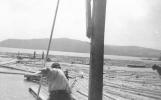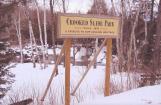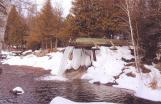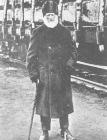1
Bill Graham, writing in the Madawaska Highlander, pointed out:'The Madawaska River witnessed some of the earliest commercial lumbering activities in Ontario, with the greatest activity occurring in the period from 1860 to 1890. as early as the 1840’s, the government was providing assistance to lumber companies by building slides and booms to facilitate log drives on the river. By 1867, the logging companies had built dams on the upper main reservoirs including Bark Lake and Palmer Rapids Dams'.
The Royal Navy, the principal buyer of lumber in the early 1800’s, demanded a set measurement for their logs; 35’ in length and 12" square, for easy loading in transport ships to England for making ship masts in the Navy’s Fleet. This resulted in an extravagant waste of wood with only 1/3 of the tree being used, and left 2/3 on the forest floor as a fire hazard. It is said that Lumber Baron J. R. Booth estimated that fires claimed 20 trees for every one that was harvested. Listed among the principal lumber merchants for the Ottawa River and the tributaries in 1851 were:
Twp of McNabb Peter Morris & Co.
Twp of McNabb William Morris
Twp of McNabb Peter Robinson
Madawaska River Thomas B. Hyde
3
Thomas B. Hyde had roots in old Bytown (Ottawa), and was an intimate friend of Thomas D’Arcy McGee. Hyde’s lumbering took him up the Madawaska River and it is conceivable that Hyde’s Bay in Combermere was named after him. Other lumber barons of note in the 1850’s were Americans E. B. Eddy, C. B. Pattee, and W. B. Perley and Canadians J. Gillies, D. McLachlin, A. Gilmour and J. R. Booth.John Egan was born in 1811 in Ireland and purchased a farm in 1837 in the community now known as Eganville. He had several years of lumbering experience working in Alymer QC and then moved to Renfrew County. Egan was quite an entrepreneur and set up a grist mill and several other businesses in the area. He was known as the 'King of the Ottawa'.
In 1836 he helped form the Ottawa Lumbermen’s Association in Bytown (now Ottawa). He commissioned the building of dams and timber slides on the rivers of the Upper Ottawa Valley including the Madawaska River.
He was rafting two and a half million feet of square timber annually to Quebec and by 1851 his company employed 2,000 men throughout the Ottawa Valley
John also founded a navigation business with two steamers the 'Emerald' and the 'Oregon' on the Ottawa River. He was a supporter of the Opeongo Road, was a Justice of the peace and was first Warden of Sydenham District and also built short railways around rapids on the Ottawa River.
His lumbering business was quite extensive and specialized in white and red pine. John passed away in 1857 when he as only 46 years of age. In 1867 his timber rights were disposed of to J.R. Booth for the sum of $45,000. His timber limits encompassed much of the Ottawa Valley and what later became Algonquin Park. John Egan was truly one of Ontario’s first lumber kings and a true entrepreneur.
If there was a 'baron above all barons', it was John Rudolphus Booth. Born in 1827 in the Province of Quebec, he tried his hand at a variety of trades until turning to the lumber trade. In 1867 he purchased the lumber rights of John Egan - 260 square miles near the Madawaska River near what is now Algonquin Park. This acreage had been returned to the Crown, and appeared on the market for sale. Booth harvested this land for the next 50 years. Nothing stopped him in his pursuit of success in the industry, often building a railroad when a river was not available for the transport of logs (some of which became part of the Grand Trunk Railway). He carried on until his death at the age of 99.
As in many things is an end, and the last raft to pass through Ottawa on the Ottawa River occurred in 1899.
On Monday night, some 250 of the men who had been employed
on the 'drives' of the various firms of lumbermen operating on the
Madawaska came into Renfrew on their way home. Their services are
dispensed with for the present, as water is too low for the logs to be
brought farther down this season. August 16, 1872 (from Bill Graham’s
Shantymen on the Madawaska from The Madawaska Highlander)
5
In the mid 1800’s logging was a very important industry in the area now known as Algonquin Park and the main river flowing out of that area called the Madawaska River. The industry employed thousands of lumbermen up until the late 1890’s. The lumbermen would leave their families in the fall of each year and go into the bush to cut, and haul the gigantic white pine trees, many of them over 3’ and 4’ in diameter, hauling them using horses to the river and let the river move the squared logs to the Ottawa River at Arnprior. At this point the logs were assembled into rafts for movement to Quebec City to be loaded onto ships for England where they were made into ship’s mast for the British Navy. The logs were squared to allow more of them to be placed in the ships hold.Many of the loggers were killed or drowned in the bush and in the log drives in the spring of each year. The logs would jam up on rocks and would have to be either dynamited to loosen them up or pike poled to loosen them. The loggers were on the logs when they slipped or got crushed between logs.
7
At the various rapids along the Madawaska River, the logging companies would build wooden sluices to move the logs around the treacherous rapids. These were designed like U shaped troughs with water running in them and logs were diverted be pike pole to go through the trough. The system worked very well - saved lives and was a faster way to get logs through rapids.10
J. R. Booth was the largest timber baron in Canada and had thousands of acres of timber rights in a large part of Ontario. His main operation was in Ottawa near the old Union train station. After the river was no longer used for movement of the logs, Booth built the Ottawa, Arnprior and Parry Sound railway in the mid 1890’s to transport the logs to their markets in the USA and Canada. That railway came to Barry’s Bay in 1894.12
Where the Madawaska River empties into Kamaniskeg Lake, there was a wooden sorting table were the logs were directed down the lake. At the bottom of the lake where Chippawa Cottage Resort is now located was an area called 'The Depot'. It was a place for further sorting of logs and a sawmill was also located there in the late 1890’s for many years.At Palmer Rapids, there was another major problem getting logs around that set of rapids. Several loggers lost their life there and were buried in a small cemetery on top of a hill at the original site of the village of Palmer Rapids off Dam Road near Jewelville.
Other sawmills in the area included Daniel Johnson’s sawmill business at Johnson Creek; Orams sawmill behind the Valley Market store on a creek there.
14
PASTWAY LUMBER MILLIn the winter of 1929 after several other careers in Saskatchewan working the wheat harvest and in Galetta lead mine Frank Pastway and his brother Steve worked together at Bruly Lake in Algonquin Park cutting logs using only cross-cut saws.
In the spring of 1936, Frank purchased a sawmill in Combermere where he used the mill to hash grain and cut wooden shingles. At the end that summer he moved the mill to Halfway and continued the same operations.
In the summer of 1937 the mill was moved back to Combermere where Frank began custom sawing for Murray Brothers, employing local men who roomed and boarded at the Pastway Mill
In the fall of 1938 the mill was completely destroyed by fire but Frank was determined to rebuild it. In the summer of 1949, disaster struck again when another fire destroyed the mill.






